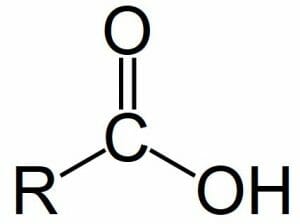Hydroxyl Group Definition
A hydroxyl group is a functional group that attaches to some molecules containing an oxygen and hydrogen atom, bonded together. Also spelled hydroxy, this functional group provides important functions to both alcohols and carboxylic acids. Alcohols are chains of carbon molecules with a functional hydroxyl group side chain. The electronegativity of the oxygen adds a slight polarity to alcohols, which is why they are able to interact with other polar molecules such as water and some solutes. Below is a general alcohol which contains a hydroxyl group. The oxygen is the red atom, while the hydrogen is represented by the grey atom. The R represent any generic carbon chain.
Carboxylic acids contain a hydroxyl group within their functional carboxyl group. A carboxyl group consists of a carbonyl group bonded to a hydroxyl group. A carbonyl group is simply a carbon double bonded to an oxygen. These two functional groups together create an extremely reactive molecule, which is prone to forming new carbon-carbon bonds. Along with alcohols, carboxylic acids are commonly seen in nature. A generic carboxylic acid with its hydroxyl group can be seen below.
Besides these two large classes of molecules that are functionally dependent on the hydroxyl group, many other molecules contain hydroxyl groups. As mentioned, a large part of the action caused by the hydroxyl group is due to the electronegativity of the oxygen. Because oxygen has a stronger attraction with the electrons bonding hydrogen to the molecule, the hydroxyl group can easily lose the hydrogen to an atom that will share electrons more equally. When this happens, the oxygen takes on a much more negative electrical energy, and can donate the extra electrons it has to a number of reactions. Biological organisms use this property of oxygen to help connect and disconnect chains of carbon molecules, which hold energy the organism can use to power cellular functions.
Related Biology Terms
- Carboxyl group – A carbon doubled bonded to an oxygen and also bonded to a hydroxyl group.
- Carbonyl group – A carbon double bonded to an oxygen and any other molecules, including more carbons.
- Electronegativity – The attraction that an atom has for electrons, compared to the other types of atoms that it shares electrons with in covalent bonds.
- Polarity – The property of a molecule that arises from the stable differentiation of electrical poles across a molecule or part of a molecule.
Quiz
1. Amino acids are the function units of protein. Each amino acid molecule contains a carboxyl group at one end, and an amino group at the other end. Amino groups consist of a nitrogen bonded to two hydrogens, which is attached to the carbon backbone of the amino acid. When the protein is formed, the carboxyl group loses the hydroxyl group attached to it, while the amino group loses a hydrogen. With the loss of these molecules, the amino group binds to the carbonyl group, forming a peptide bond. What else is produced during this reaction?
A. Water
B. Energy
C. Heat
Hydroxyl Group


No comments:
Post a Comment